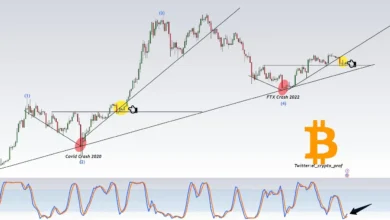
Bitcoin Drops Below $106K, Institutions Buy the Dip
The Bitcoin price drop dropped drastically below the psychologically significant $106,000 barrier on May 30, 2025, thereby upsetting the Bitcoin Market and sparking a frenzy of activity among investors and traders alike. With a near 3% drop in a short period, this abrupt decline has triggered a wave of individual investor selling pressure, as they are cautious of short-term volatility. Savvy investors and companies are seizing the opportunity to buy the dip amid the panic and uncertainty, demonstrating unwavering faith in Bitcoin’s long-term prospects and its function as a digital store of value.
Although the price swings in the Bitcoin price drop market have long been well-known, these periods of turbulence often present strategic access opportunities for astute players. The backdrop of larger economic and geopolitical events, as well as the changing narrative on Bitcoin’s intrinsic value, supply dynamics, and institutional acceptance, should help one interpret its correction on May 30. Gaining an understanding of these elements will help one to appreciate why this downturn is causing an obsession with accumulation instead of anxiety.
Macroeconomic Forces Driving Bitcoin Decline
The latest decline in Bitcoin can be attributed to a convergence of macroeconomic forces affecting global markets. Rising geopolitical tensions, changing interest rates, and concerns about inflation have all diminished risk appetite across asset classes, including cryptocurrency. Furthermore, traders remain unsettled about the unresolved questions concerning regulatory systems, particularly in significant economies such as the United States and the European Union.

Furthermore, the activity of the U.S. dollar greatly influences Bitcoin’s price action. Historically, the U.S. dollar index (DXY) has shown a positive correlation, whereas Bitcoin has demonstrated an inverse one. When investors migrate toward safer fiat assets, Bitcoin usually declines when the dollar strengthens. Macro strategist Jamie Coutts of Real Vision notes, though, that the recent dramatic drop in the dollar points to possible upside for Bitcoin in the following months. Coutts notes that past dollar declines have sometimes followed strong rallies in risk assets, implying Bitcoin might be prepared for a comeback after this dip.
Institutional Bitcoin Accumulation Signals Market Maturation
The way institutional players behave distinguishes this Bitcoin correction from earlier sell-offs. Some of the most significant institutional funds and corporate holders are speeding up their accumulation instead of withdrawing. Leading Bitcoin evangelist and former CEO Michael Saylor’s MicroStrategy has recently increased its Bitcoin reserves by acquiring approximately 4,000 more Bitcoins in the second half of May. With MicroStrategy’s entire hoard worth more than 580,000 Bitcoins, this most recent acquisition increased their total to almost $40 billion. Saylor’s optimistic posture bets on Bitcoin as a pillar asset for corporate treasury management and a counter-agent against inflation.
Analogously, BlackRock’s iShares Bitcoin Trust (IBIT), which has grown rapidly to become one of the most significant institutional Bitcoin funds, now holds approximately 600,000 Bitcoins. This noteworthy ownership highlights how more conventional financial institutions are embracing Bitcoin and taking deliberate steps to include exposure to cryptocurrencies in their diversified portfolios. Thanks to controlled investment vehicles like IBIT, the influx of institutional money signals the maturation and legitimization of the Bitcoin market.
Bitcoin Support Whales Halving Impact
Technically, Bitcoin’s decline to nearly $106,000 tested critical support zones that had been developed recently. Market analysts view these levels as crucial turning points, when buyers typically step in to defend pricing. The well-known “buy the dip” mindset, which permeates seasoned crypto investors who recognize that brief declines are inevitable in Bitcoin’s price cycles, fuels some of the dip purchasing frenzy.
Furthermore, large Bitcoin holders known as”whales, initiated their accumulation pattern in early March. Often a precursor to increasing price momentum, this activity signals market confidence and typically motivates smaller traders to follow the moves of these investors.
Scheduled for April 2026, the upcoming Bitcoin halving event adds another layer of positive sentiment. Historically, notable price swings have accompanied Bitcoin’s halvings—that is, halving of the mining payouts. Reducing new supply usually results in scarcity; combined with rising demand, it can put increasing pressure on pricing. Predicting that Bitcoin might rise toward a cycle high near $150,000 post-halving, analysts at Bernstein have described the present phase of consolidation as a “dip buying opportunity.”
Bitcoin’s Long-Term Value
Those debating whether to buy Bitcoin, given its current volatility, must adopt a long-term view. The special qualities of Bitcoin as a decentralized, censorship-resistant, scarce digital asset have progressively come to notice. Especially in light of concerns about fiat money debasement and economic instability, the story of Bitcoin as “digital gold” remains resonant with people.

Through long-term, large-scale ownership, institutional inflows not only offer liquidity but also help anchor prices, thus lowering volatility. Rising financial products, such as Bitcoin ETFs, trust funds, and custody services, also enhance market accessibility and security, thereby motivating broader usage.
Moreover, advancements in blockchain technology, improved regulatory clarity, and integration with conventional financial systems will help Bitcoin become more valuable and resilient.
Final thoughts
Though it may have scared short-term traders, Bitcoin’s Path collapse below $106,000 on May 30, 2025, is driving a purchasing frenzy among educated institutions and investors. This paradox highlights a fundamental truth, although in traditional finance, disturbing and unsettling trends are often present. However, the fact that these trends typically offer opportunities to build quality institutions, provide strong macro signals, and a significant forthcoming supply event, suggests that Bitcoin is experiencing considerable growth over the next 12 to 18 months.
Investors trying to navigate the title market should concentrate on in-depth research, understanding the macroeconomic background, and the evolving buying landscape, as well as the global cryptocurrency market. Buying landscape strategically during this dip could pay you handsomely; hence, May 30 is not just a day of fall, but also a key turning point for those who buy the dip.







